This article was originally published by National Geographic’s Water Currents.
The original can be found here.
Yaqui River, Sonora, Mexico, as it flows (or not) through the Yaqui Nation (Jíak Batwe, Yaqui or Yoeme language) (Río Yaqui, Spanish)
Compare and contrast:
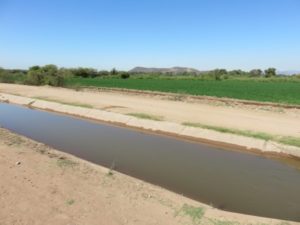
By Basia Irland
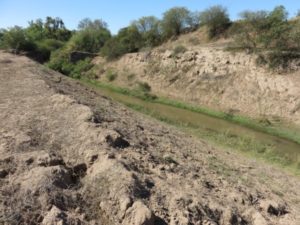
My struggle as a river is interconnected with the struggle of my people, the Yaqui Indigenous Community of Mexico in the Sonoran desert, as I try to provide the ancestral source of water for drinking, everyday use, irrigation, and ceremonial purposes. Together we have had a long and complex history. Manuel Esquer Nieblas, a member of the Yaqui Defense Brigade, grew up playing in my waters during a time when there was still some flow. His relatives live in several of the eight remaining Yaqui villages along my northern banks as I move south and empty into the Gulf of California 28 miles (45 km) southeast of Guaymas.
My water that is destined for Yaqui land is diverted for the cultivating of hybrid wheat, corn, and rice impregnated with synthetic fertilizers. Utilizing high-tech farming methods, the crop yields have been impressive, but little, if any, of the money made from these fields goes to the Tribes, and most of the noxious pesticide runoff is funneled into channels that dump directly into my body. Ugh. It makes me ashamed to tell you this, and for you to hear about what shape I am in these days.
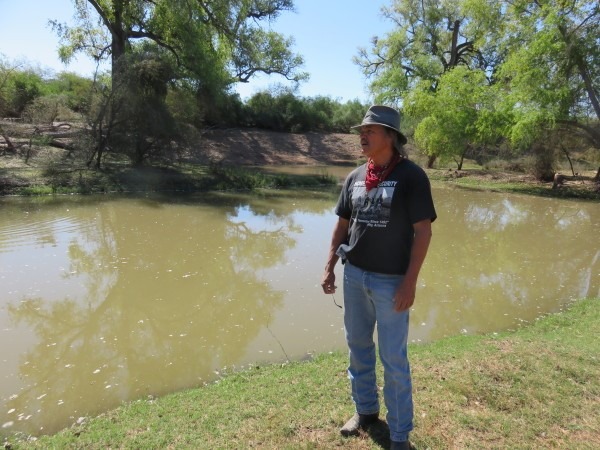
In 2015, Manuel stands beside me and chats with a family who must wash their clothes in this putrid mess, because they have no running water in the village of Tórim. And when I slog on to the village of Bakum, I have to witness poor families forced to purchase drinking water since none is available within the homes. Four gallons of bottled water costs around thirteen or fourteen pesos, or about one dollar in U.S. currency. Four gallons is not much water, and with so few pesos coming into the household, this is an extravagant amount of money for a necessity that should be free, and a given right for all people.
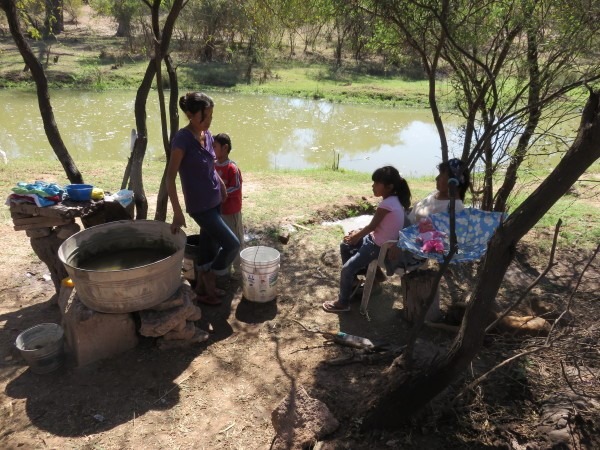
There are regularly scheduled Tribal council meetings about what to do concerning the water situation. Since May 2013 one form of protest has been to maintain a resistance camp and roadblock at Vicam (the Tribe’s main headquarters) to stop large transport trucks along the Mexico City to Nogales Federal Highway #15. As a result of this action, the Mexican government issued criminal charges and arrest warrants against two of the Yaqui leaders. Amnesty International has denounced this action in an open letter stating that Amnesty fears the charges are a “reprisal against their legitimate work on behalf of their people’s human rights.”
A brief history of me and my people is important in order to put into perspective what is happening today. As early as 500 AD, native inhabitants known as the Yoem Vatwe or Yaqui were living along my shores in small family units. The Yaqui used simple irrigation techniques to transport me for the growing of squash, corn, and beans. In 1533 a Spanish military expedition searching for slaves began a war. They were defeated, but killed thousands of Yaqui people. Even in the early 1600’s, the Spanish repeatedly attacked Yaqui settlements. Then again around 1684, when silver was found near my banks, the Spanish attempted to move into the region. But throughout the turbulence, the Tribes continuously attempted to defend me, the land, and their culture.
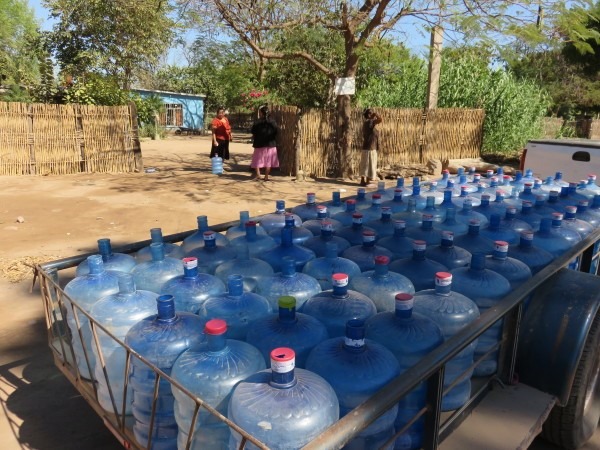
The villages were fairly independent until the late 1800’s, when a different enemy appeared. The Mexican Army forced families to flee to other areas, with some groups relocating to Yaqui communities in Arizona. By the late 1880s, warfare with the Mexican Army had killed off many members of the Yaqui Tribe.
In the early 1900s, after a series of conflicts with the Mexican Army, numerous remaining Yaqui were arrested and dispersed to plantations in the Yucatán Peninsula. The survivors continued resisting until the late 1920s, when Mexican authorities overcame resistance by employing heavy artillery, and even dropped bombs on Yaqui villages.
Mexican troops occupied Pueblos to keep watch over them, and deported many to work as slaves in distant areas within Mexico, and abroad. In 1939, Mexican President Cardenas tried to change the attitude about the Yaquis by granting the Tribe official recognition and title to their land.

But the struggle is not over, because land and water rights issues remain contentious to this day. The most recent obstacle has been the building of the Independence Aqueduct, which was built to transport water from my body to Sonora’s capital, Hermosillo, a manufacturing hub with high-water use plants such as Heineken, Ford, and Big Cola. Yaqui leaders have stated that about 40 percent of the municipal water supply in the capital city is being lost to faulty infrastructure. The diversion began operating in April 2013 in spite of protests, injunctions, and court orders from the Tribe, who have first rights to my water.
On July 9, 2013 the Zapatista General Command, together with the Mexican Indigenous National Congress, issued a statement of solidarity and support for the Yaqui, condemning the “theft” of water and the “criminalization of their struggle.” In December of 2014 a conference titled “Pillage of the Water of the Pueblos: New Challenges” took place in Mexico City. Many speakers described how even with all the legal injunctions against the building of the aqueduct, the project proceeded, and even with all the promises of wells from the government, nothing still has been done to provide clean water to the Yaqui People.
There are now sections where I dry up and disappear entirely, with nothing in the riverbed but dust. So, the struggle for my survival and that of my people continues!
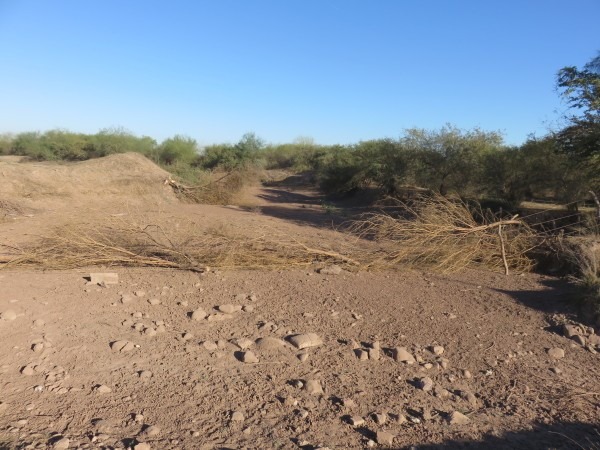
Basia Irland is an ecological artist, professor emerita at the University of New Mexico, and creator of the Ice Receding/Books Reseeding project. She has focused her art on rivers for the past thirty years. Irland’s work appeared in the March-April issue of Orion magazine and was highlighted in the September 2013 issue of Sculpture magazine. For more information, visit Irland’s website.
This article was originally published by National Geographic’s Water Currents.
The original can be found here.
Basia Irland also sculpts “ice books” to transform art into civic engagement with the Earth and inspire action to save the planet’s rivers. The MAHB featured these sculptures in an earlier post, Ecological Artist Basia Irland and Her “Ice Books” Engage Communities and Restore Rivers by Sandra Postel and Basia Irland, and will be sharing some additional essays from Irland in the coming weeks.
This post is part of the MAHB’s Arts Community space –an open space for MAHB members to share, discuss, and connect with artwork processes and products pushing for change. Please visit the MAHB Arts Community to share and reflect on how art can promote critical changes in behavior and systems. Contact Erika with any questions or suggestions you have regarding the new space.
MAHB Blog: https://mahb.stanford.edu/creative-expressions/yaqui-river/
The views and opinions expressed through the MAHB Website are those of the contributing authors and do not necessarily reflect an official position of the MAHB. The MAHB aims to share a range of perspectives and welcomes the discussions that they prompt.